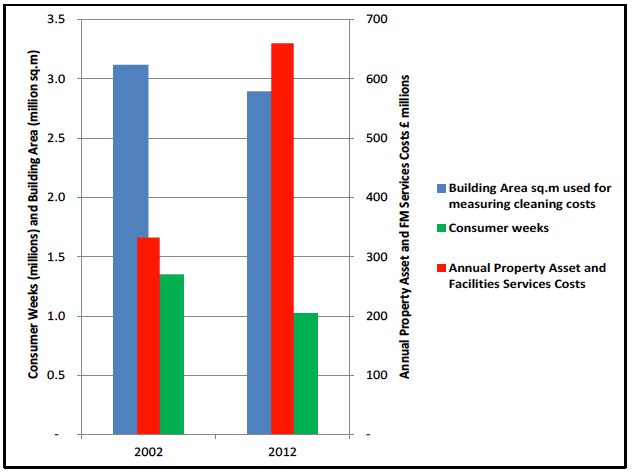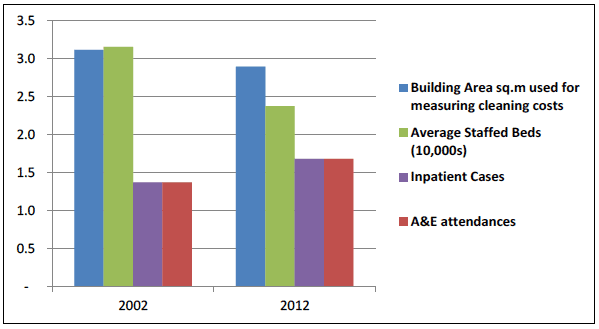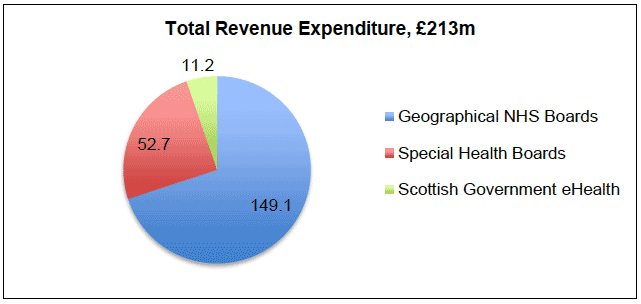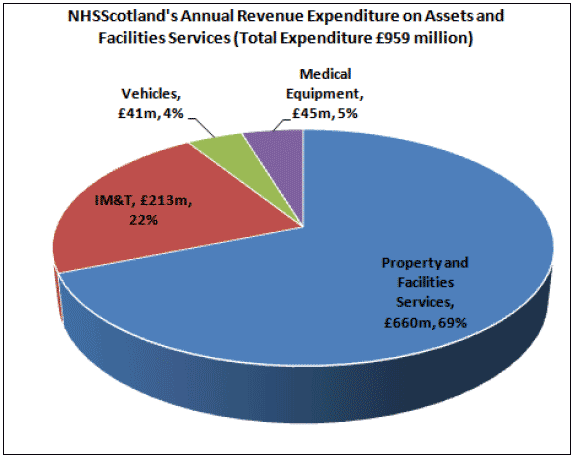Annual State of NHSScotland Assets and Facilities Report for 2013
A review of asset and facilities management performance in NHSScotland, identifying the current state of the estate and facilities management, highlighting areas of best practice and areas for improvement.
3.0 The annual cost of assets and facilities services
The revenue and lifecycle costs associated with asset ownership and use represent a considerable proportion of NHSScotland budgets. This section of the report provides a summary of the annual cost of asset ownership and facilities management services.
3.1 Property Assets and Facilities Services - Annual Costs
There are significant annual revenue costs that are directly associated with property asset ownership including:
- Property Maintenance (regular day to day maintenance - excluding major capital expenditure on upgrading/refurbishment and backlog works)
- Energy
- PFI Facilities Management Costs (primarily Hard FM)
- Rates
- Cleaning
There are also a range of facilities management services costs that are closely associated with property asset ownership including:
- Catering
- Portering
- Laundry and linen
- Waste disposal
The table below provides an analysis of these costs for the Hospital Sector of NHSScotland for 2010/2011 and 2011/12 and shows a 3% overall increase on the year, which is below national RPI inflation of 3.6% at March 2012.
| Annual Property Asset and Facilities Services Costs |
|||
|---|---|---|---|
| Expenditure £ |
Expenditure £ |
Percentage Change over Year |
|
| Property Maintenance (capital and revenue costs) |
113,949,249 |
117,679,791 |
3% |
| Cleaning |
117,128,872 |
117,425,095 |
0.3% |
| PFI Facilities Management Costs |
101,674,478 |
106,949,026 |
5% |
| Catering |
80,866,039 |
81,039,194 |
0% |
| Energy |
72,311,800 |
89,688,057 |
24% |
| Rent |
60,303,082 |
9,028,816 |
-9% |
| Rates |
46,071,140 |
||
| Portering |
47,285,685 |
47,532,728 |
1% |
| Laundry and linen |
34,164,405 |
33,566,916 |
-2% |
| Waste Disposal |
10,022,261 |
10,779,203 |
8% |
| Total |
637,705,871 |
659,759,966 |
3% |
Note: Excludes capital charges and depreciation on property asset; costs associated with Community and Family Health Services and energy costs exclude costs associated with environmental taxes and levies e.g. EU ETS Payments
Note: Although energy prices rose by 24% between 2010/11 and 2011/12, actual energy consumption (uncorrected for weather influences) reduced by c 9.5% over the same period. Utility energy prices continue to rise over the rate of inflation, and so future energy consumption reductions will seek to offset, rather than reduce, energy costs.
The chart below provides an analysis of these property asset and facilities services costs over the last decade and compares this with the changes in building area and consumer weeks (the number of patients occupying a hospital bed over a week i.e. a proxy measure for inpatient activity) over the same period. Within this period property asset and facilities services costs have increased by 100%, whereas general inflation based on the Retail Price Index (RPI) has only increased by 38% over the same period. One reason for this may be improved investments in assets and facilities over this period but further analysis will be carried out on these cost pressures for next year's SAFR report. Also, during the same period building area has reduced by 7% and consumer weeks has reduced by 25%.

The chart below compares the reduction in building area (7%) with the changes over the same period in average staff beds (25% reduction), inpatient cases (14% increase) and A&E attendances (23% increase).

Given that staffed beds are a major driver of space requirements in acute hospitals (much more so than A&E attendances or inpatient cases) it is unexpected that the 25% reduction in staffed beds has not resulted in a greater reduction in the overall building area. This may be accounted for by increasing space standards i.e. greater numbers of single rooms, increased bed spacing etc. Further analysis of these issues are to be investigated further and incorporated into the 2014 SAFR report.
3.2 Property Assets - Lifecycle and Backlog Maintenance Costs
In addition to the regular day to day maintenance costs included in the annual property maintenance figures shown above, property assets require regular expenditure on lifecycle replacement of building and engineering elements of the estate. Historically, NHSScotland has invested too little on these lifecycle replacements, hence the build-up of a significant backlog maintenance expenditure requirement (currently £858 million). However, over recent years Boards have had a particular focus on reducing backlog through targeted expenditure on high and significant risk backlog and rationalisation of the estate. This has resulted in a £152 million reduction in the backlog expenditure requirement since 2011.
In addition, NHSScotland's substantial capital investment programme over recent years has reduced the backlog expenditure requirement through new-build projects which replace old buildings and refurbishment schemes which incorporate backlog within the works. Projections of planned future expenditure on backlog maintenance and replacement of the estate are provided later in this report (Section 4: Planned future investment in Assets).
3.3 Vehicles - Annual Costs
NHSScotland's estimated annual expenditure on its vehicles assets, as indicated through NHS Board information returns, is shown in the table below.
| Annual Expenditure on Vehicle Assets |
||||
|---|---|---|---|---|
| Description |
£ |
% of Total |
No. of Vehicles |
Average per Vehicle |
| Insurance & accident costs (net cost) |
£5.10m |
9.46% |
10,909 |
£467 |
| Fuel costs |
£13.44m |
24.92% |
10,909 |
£1,232 |
| Maintenance & servicing costs - owned vehicles |
£5.96m |
11.06% |
1,917 |
£3,111 |
| Leased vehicle costs (including maintenance) |
£5.03m |
9.33% |
2,101 |
£2,395 |
| Hired vehicle costs |
£1.10m |
2.05% |
181 |
£6,092 |
| Staff car scheme lease costs (including maintenance & mileage claims) |
£23.28m |
43.18% |
6,710 |
£3,469 |
| Staff contribution towards private use |
-£12.72m |
- |
6,710 |
-£1,896 |
| Total Net Costs |
£41.19m |
100% |
10,909 |
£3,776 |
Note: excludes capital charges and depreciation on owned fleet.
In addition to the above, many NHSScotland staff use their private vehicles for official business and claim fuel and running costs of circa £23m through expenses claims.
The Transport & Fleet Management Review is looking at ways in which improvements can be made to the efficiency and effectiveness of this fleet aimed at reducing these operational costs.
3.4 Medical Equipment - Annual Costs
The annual expenditure on medical equipment by Boards is shown in the table below.
| Description |
Total £ |
% of Total |
|---|---|---|
| Revenue Expenditure (on medical equipment) |
£16.6m |
37% |
| Maintenance on renal dialysis equipment, flexible endoscopes, and cardiac defibrillators |
£3.4m |
8% |
| Maintenance on radiotherapy and imaging equipment |
£13.5m |
30% |
| Leases |
£1.0m |
2% |
| Managed equipment services |
£10.2m |
23% |
| Total |
£44.7m |
100% |
Note: excludes capital charges and depreciation on owned equipment, and maintenance on general medical equipment. It also excludes capital expenditure on equipment replacement.
As with property assets, there is a need to balance investment between ongoing annual maintenance of medical equipment and investment in its lifecycle replacement. As equipment life is relatively short (often less than 15 years) the level of maintenance needs to be sufficient to ensure its continued availability and effectiveness within that period whilst accepting that other considerations, such as technical obsolescence, can influence the need to replace equipment earlier than planned; which can introduce benefits of new technology offering improved patient care, reduced radiation doses and reduced costs.
3.5 IM&T - Annual Costs
The IM&T survey identified that the overall level of expenditure by NHSScotland on IM&T in 2011/12 (the base date for the expenditure analysis), was £236.5m. Of this total, £213m was incurred on expenditure items of a revenue nature, with £23.5m incurred on capital expenditure. An analysis of the revenue expenditure is shown in the chart below.

The capital expenditure on IM&T of £23.5 million in 2011/12 is similar to that planned by Boards over the next 5 years (£26 million per annum)
The total revenue expenditure of £213m is split as follows:
- £57.5m (27%) of non-recurring expenditure by NHS Boards to support national systems and deliver eHealth strategic priorities.
- £91.5m (43%) of revenue expenditure by NHS Boards.
- £53m (25%) of revenue expenditure by Special Health Boards.
- £11m (5%) expenditure by the Scottish Government eHealth Division.
The table that follows provides a summary of the overall total revenue expenditure incurred by NHSScotland expressed as a percentage of Revenue Resource Limit (RRL) for 2011/12. By taking RRL as a proxy for NHSScotland's overall annual revenue expenditure it is possible to obtain an indicative measure of the level of overall revenue resource committed to IM&T by NHSScotland.
| Revenue Expenditure by NHS Board |
RRL Percentage (%) |
Revenue Expenditure by NHS Board |
RRL Percentage (%) |
|---|---|---|---|
| Geographical NHS Boards |
Special Health Boards |
||
| Ayrshire & Arran |
1.82 |
NHS24 |
13.31 |
| Borders |
2.46 |
Golden Jubilee ( NWTC) |
2.34 |
| Dumfries & Galloway |
1.92 |
NHS Health Scotland |
3.00 |
| Fife |
1.57 |
Healthcare Improvement Scotland |
1.73 |
| Forth Valley |
1.31 |
National Education Services |
0.61 |
| Grampian |
1.48 |
National Services Scotland |
7.07 |
| Greater Glasgow & Clyde |
1.81 |
State Hospitals |
2.11 |
| Highland |
1.75 |
Scottish Ambulance Service |
6.05 |
| Lanarkshire |
1.63 |
Average: |
4.37 |
| Lothian |
1.34 |
||
| Orkney |
2.27 |
||
| Shetland |
2.41 |
||
| Tayside |
1.82 |
||
| Western Isles |
2.27 |
||
| Average: |
1.67 |
||
| Total: 2.11 |
|||
Based on information from the IM&T Survey on NHSScotland expenditure for 2011/12
The table identifies that in 2011/12 the overall level of revenue expenditure on IM&T incurred by NHSScotland was 2.11% of its overall RRL. The table also shows that NHS Boards spent between 1.31% and 2.46% of their RRL on revenue IM&T expenditure, while Special NHS Boards typically spent higher percentages reflecting the different nature of the services they provide. This is particularly evident in the case of NHS24, which spent 13.31% of its RRL on revenue IM&T expenditure.
3.6 Summary of Total Annual Asset and Facilities Costs
The chart below provides an analysis of the combined total asset and facilities annual expenditure that has been described earlier.

Notes: 1) Excludes capital charges and depreciation costs associated with asset ownership
2) Excludes any annual expenditure on lifecycle replacement and backlog maintenance
It should be noted that the above annual expenditure on assets excludes capital expenditure on:
- Replacement of existing assets - both major capital schemes (Board capital and NPD) and smaller schemes procured through hubco.
- Replacement of major existing equipment - medical equipment, vehicles and IM&T - procured through revenue or Board capital.
- Major lifecycle maintenance/backlog such as boiler and major infrastructure and backlog replacement - procured through revenue and Board capital.
Contact
Email: Gillian McCallum
There is a problem
Thanks for your feedback